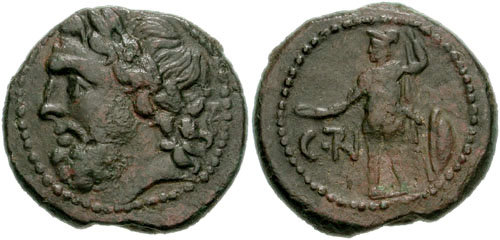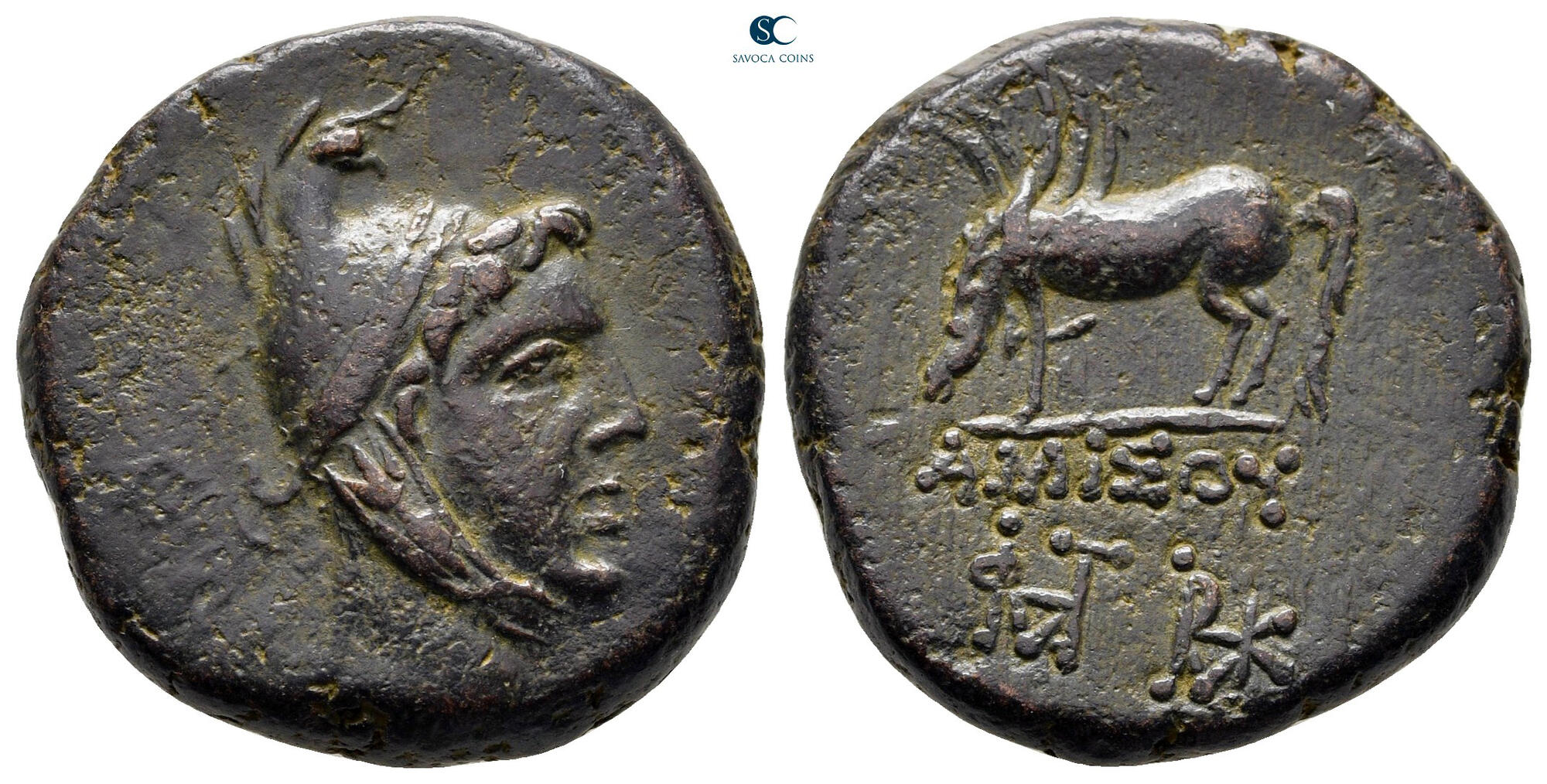-
Posts
57 -
Joined
-
Last visited
Content Type
Profiles
Forums
The Numis Journal
Events
Downloads
Gallery
Store
Classifieds
Posts posted by Herodotus
-
-
It looks similar to an Æ coin type that was minted in Sicily(Panormos)-- featuring Zeus & Warrior w/ patera/spear/shield.
-
 5
5
-
 3
3
-
-
The best option is to pay the invoice with a credit card that does not charge a currency conversion fee -- IE. Capital One(U.S. issued card) has no foreign currency conversion charges. I can't speak for what cards may be available abroad that offer the same service.
That stated, many auction houses will still charge a payment processing fee(usually around 4%*).
Of note, PayPal gives the option of having them do the conversion(at an unfavorable rate), or to have the credit card being used for the transaction to do the conversion -- the better option if it offers no/or a nominal conversion fee.
*This processing fee can be somewhat offset if the credit card is a rewards card that offers 'points' or 'cash back' for purchases.
-
 1
1
-
-

Severus Alexander. (AD 222-235). AR Denarius. Rome mint.
Struck (AD 228)
OBVERSE: IMP SEV ALEXAND AVG; Laureate head right.
REVERSE: VIRTVS AVG; Severus Alexander (as Romulus) advancing right, holding transverse spear and trophy.
RIC IV 224
-
 15
15
-
-

Elagabalus. (AD 218-222). AR Denarius. Rome mint.
Struck (AD 221).
OBVERSE: IMP ANTONINVS PIVS AVG; Laureate and draped bust right; horned.
REVERSE: P M TR P IIII COS III P P; Elagabalus standing left, holding cypress branch and sacrificing with patera over lighted altar to left; star to left.
RIC IV 46
-
 16
16
-
 1
1
-
-

ATTICA, Athens. AR Tetradrachm. Circa (454-404 BC). (24mm 16.80g)
OBVERSE: Helmeted head of Athena right, with frontal eye
REVERSE: AΘE; Owl standing right, head facing, closed tail feathers; olive sprig and crescent to left; all within incuse square.
HGC 4, 1597
-
 13
13
-
 1
1
-
-
Тролли останутся троллями
-
 3
3
-
 3
3
-
 2
2
-
 1
1
-
-

Trajan. (AD 98-117). AE Sestertius. Rome Mint. (33mm, 26.24g).
Struck (AD 114-117).
OBVERSE: IMP CAES TRAIANO OPTIMO AVG GER DAC P M TR P COS VI P P; Laureate and draped bust of Trajan right.
REVERSE: SENATVS POPVLVSQVE ROMANVS; Felicitas, draped, standing left, holding up caduceus in right hand and cornucopia in left; S-C.
RIC 671
-
 16
16
-
-

Domitian. (AD 81-96). Æ As. (29mm, 13.19 g). Rome mint.
Struck (AD 86).
OBVERSE: IMP CAES DOMIT AVG GERM COS XII CENS PER P P; Laureate bust right, wearing aegis.
REVERSE: MONETA AVGVSTI / S - C; Moneta standing left, holding scales and cornucopia.
RIC II.1 493
-
 19
19
-
 1
1
-
 1
1
-
-
A little late to this one.
But, since we're still in the Julio-Claudian era... How about the brother of Tiberius, the father of Germanicus and Claudius, and the grandfather of Caligula?

Nero Claudius Drusus. (Died 9 BC). Æ Sestertius. Rome mint. (36mm, 28.05g).
Struck under Claudius, (AD 42-54).
OBVERSE: Bare head left.
REVERSE: Claudius seated left on curule chair, holding branch and scroll; below, weapons and armor on either side of globe.
RIC I 109 (Claudius)
-
 14
14
-
-

Thrace, Hadrianopolis. Caracalla. (AD 198-217). AE27(Tetrassarion?).
O: AYT K M AYP CE ANTΩNEINOC; Laureate, draped bust right.
R: AΔPIANOΠΟΛEITΩN; Herakles standing left, resting right hand on club set on bucranium; holding lion skin in his left hand.
Varbanov 3534; Moushmov 2654; Jurukova 301
-
 13
13
-
-
Zenobia?
-
 1
1
-
-
3 hours ago, sand said:
Interesting. I don't speak much Spanish. I plugged "campos repasados" into the Google search Spanish-to-English translator, and the result was "fields reviewed", which seems like it could mean "fields tooled" or "fields smoothed". Perhaps the Google search Spanish-to-English translator is not very accurate, for numismatic phrases.
A more apt translation to English would be: 'reworked fields'.
Las monedas repasadas = 'reworked coins'.
-
 2
2
-
-
I had an eye on the Mercury/Prow R.R. Sextans that the seller was also offering. It went for more than I was willing to spend.
Something about the 'style' of the O.P.'s coin didn't/doesn't sit right for me. I get a 'Paduan' vibe from it. Since I trust my gut, I decided to not give it further interest.
That stated, my 'Spidey-Sense' is not infallible. If the only loss is potentially missing out on a coin I'm unsure about; I don't fret too much about it.
What I don't like is the style of the hair. It's 'brain-like' structure(for lack of a better descriptor) looks more akin to what one would see on a Julio-Claudian Sestertius than an Adoptive Emperors Sestertius. Could it by a sign of 'tooling' on a genuine coin? I dunno.
The small (circular)moon craters on the reverse also lend me to take pause. They look like popped air-bubbles.
This is RIC 706j. Notice the the 'thicker locks' hairstyle which is what I am more accustomed to expecting on Hadrian portraits.

I'm certainly far from being expert enough to be able to condemn or confirm the OP coin's authenticity, I'm simply expressing the concerns that I had in leading my decision to pass on any further interest for it.
-
 2
2
-
-
Interesting.
Of course, what might be considered as improvement may be in the eye of the beholder.
In some cases, such as the Lysimachos, there was an obvious improvement. In others, once the horn silver was removed, rough surfaces were exposed. Or, where toning was removed, the loss of contrast made the devices look flatter or more mushy. In my opinion, a nice natural toning can actually improve a coin’s details by adding a ‘shadowing’ effect in the layers of the devices — As is the case with my thinking that the Antiochos I Tet’s appearance was more appealing beforehand.
That stated, most of these turned out improved.
Thanks for sharing.
-
 2
2
-
-
2 hours ago, Ryro said:
seeing his name as derP
😂
This was what was standing out to me; the ‘DERP’ right in front of the bust’s forehead.
-
 1
1
-
 5
5
-
-
On 8/10/2022 at 9:24 PM, NathanB said:
Finally, you may wish to part with a section of your collection to see how it all feels to you as a seller. Make this a manageable amount that you can work with. If it's a success, you can repeat it again--on the same scale, or on a larger one.
This is my suggestion as well. Test the waters a little before jumping all in.
E.G., consign a few coins with Stacks, Heritage, Great Collections, etc.
See how the entire process goes with each, and if it passes muster for you.
-
 2
2
-
 1
1
-
-
A little weakly struck in spots, but mostly all there on both sides.

-
 13
13
-
-
That portrait definitely looks like Tiberius.
However, this came up in my search:

Roman Provincial
Domitian Æ Diobol of Alexandria, Egypt. Dated AD 92-93. 7.45 g. Laureate head r. / Apis bull standing r., LZ above. Emmett 279; RPC II 2581. 5.99g, 24mm, 12h. Very Fine.-
 2
2
-
 1
1
-
-
Frank has purchased a few coins from me over time.
#16 in this upcoming auction used to reside in my collection. My photo is closer to its actual appearance in hand.

ZEUGITANIA, Carthage. Time of the Second Punic War. (215-201 BC). Æ20. Shekel(?) (20mm, 3.88 gm). Sicilian mint?
O: Wreathed head of Tanit left.
R: Horse standing right, head reverted.
-
 7
7
-
-
Yes, it appears to be an example of both expertly cleaned and tooled. In the process of removing the encrusted adhesions; also removing small amounts of the metal in each groove/valley to additionally enhance the details.
It looks to be one of those times where an acceptable amount of cleaning may then overlap with smoothing & tooling modifications.
The underlying question comes down to: What part of the patina is part of the original coin that has been naturally altered/formed, and what part of the patina has been introduced in the form of encrustations from the ground where the coin remained?
The coin has obviously been tooled, smoothed and artificially re-patinated. One point of view may be that the details have been restored. However, it is obviously an artist's interpretation of what those details may have originally been.
Most collectors desire original (AKA unaltered) coins.
-
 4
4
-
-
Is the obverse on the 1st coin on its side(needing to rotate 90° to the right), perhaps?
I'm getting a panther-like vibe on the reverse, but I admit that's a stab in the dark.
-
I haven't had a chance to properly photograph this one(the reverse was taken beneath a plastic flip; creating a glare along the top).
However, wanting to contribute to this thread, here it is:

Claudius. (AD 41-54). Æ As. (30mm, 10.80g). Rome mint.
(Struck AD 42-43).
O: TI CLAVDIVS CAESAR AVG P M TR P IMP P P; Bare head left.
R: LIBERTAS AVGVSTA / S - C; Libertas standing right, holding pileus in right hand and extending left arm.
RIC 113
-
 10
10
-
-
"Zombie Valeria"

Galeria Valeria. Augusta. (AD 293-311). Æ Follis. (25mm, 4.26g). Heraclea mint.
2nd officina. Struck circa (AD 309-310).
O: GAL VALERIA AVG; Draped bust right, wearing stephane.
R: VENERI VICTRICI; Venus standing left, holding up apple and raising drapery over shoulder; HTB(mintmark) in exergue.-
 8
8
-
-
I too am getting an Athena/Cow(or Horse) grazing vibe as well. I think that @Kamnaskiresis likely spot on here.
The one other coin type that the reverse reminds me a little of are the ones that were minted in Pontos, Amisos (under Mithradates VI); portraying Perseus on the obverse, and Pegasos grazing on the reverse. However, I'm not too confident it's a match, as the helmet in the OP looks more Corinthian in style than that of a Phrygian cap. These also vary in size from around 22-25mm, so.....
I have an example of the type, but it's not yet photographed.
Here is another example recently offered by Savoca:

-
 4
4
-



















Valeria.jpg.0a2ac9c61578c47307a96b8907879a71.jpg)

A « WOW » AUREUS OF PERTINAX
in Roman Empire
Posted
Much more prestigious than that.
The collection of Vicomte de Bragelonne.